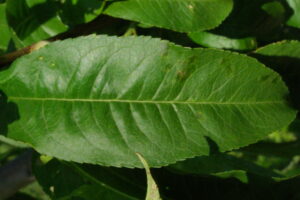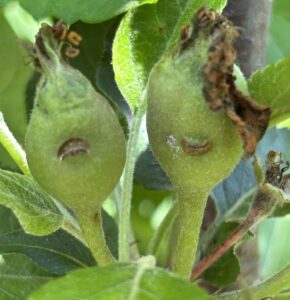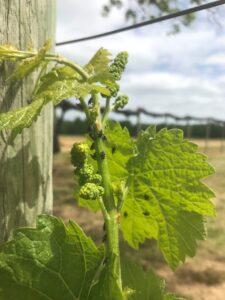Peach:
Bacterial Spot: Copper formulations should be used starting at petal fall to suppress bacterial spot. Generally we recommend starting at 0.5 ozs metallic copper and gradually lowering the rate as the season progresses. The rate applied will depend on the formulation. Dr. Lalancette published a chart listing common copper formulations and rates for peach and nectarine applications. Avoid combining copper with captan especially if it has been overcast for several days. Also avoid acidic spray solutions when applying copper. Dr. Lalancette has published a handy guide for copper applications in early covers. Antibiotics containing oxytetracycline may also be used and may offer slightly more residual activity during long wetting periods. We have observed bacterial leaf spot symptoms in the field starting last week (Figure 1).

Figure 1. Bacterial leaf spot in peach. Photo by Dave Schmitt.
Oriental Fruit Moth: We have recorded high OFM trap captures this season throughout the state. A biofix point for OFM was set on 4/2 for southern counties and 4/17 in northern counties. The first of two insecticide timings for first generation Oriental Fruit Moth control fall at 170-200 degree days base 45 after biofix. This timing generally coincides with 100% petal fall in peaches. Timings are updated below: Do not apply insecticides until all bloom is off. No Insecticides for OFM are needed where Mating Disruption is implemented.
| OFM 1st Generation Timing | |||
| Insecticide Type | |||
| County/Region | Degree Days by 5/12 base 45 | Conventional
170-200, 350-375 |
Diamide
100-150, 300-350 |
| Gloucester – Southern | 555 | 1st –past
2nd – past |
1st –past
2nd –past |
| Middlesex – Northern | 444 | 1st –past
2nd –past |
1st – past
2nd –past |
Green Peach Aphid: GPA colonies begin forming sometime during bloom. Examine trees for the presence of colonies from pink to shuck split. Count the number of colonies on ten trees and use a treatment threshold of 2 colonies/tree at petal fall for peach, and 1 colony/tree for nectarine. The best way to scout for aphids during bloom is with a beating tray. This is particularly important for nectarine blocks. If more than 1 colony of aphids are found in nectarines, or 2-3 colonies are found in peaches, an insecticide for aphids will be needed when all petals are off. See the NJ Commercial Tree Fruit Production Guide for recommended materials and rates. Aphid colonies curling leaves was noted in southern counties starting the week of 4/28.
Plum Curculio; Tarnished Plant Bugs; and Other Catfacing Insects: Last week we observed on average 1% injury on developing fruit from PC (Figure 2), specifically apples, in southern counties. This is an increase from 0.3% injury observed from last week.

Figure 2. Injury to developing fruit from plum curculio oviposition in apple.
Plum Curculio start to move into orchards at about 88-100 degree days base 50 after January 1. Applications for PC should be initiated once all petals are off, with a second application made with ovicidal materials at 379-402 DD. Currently we have accumulated about 452 DD base 50 in southern counties, and 397 DD base 50 in northern counties. Growers can monitor degree day development at their site by finding the nearest weather station and using the degree day development tool at NEWA. Catfacing insects are active now and can cause injury. Greater than 1 to 2% fresh catfacing injury on the fruit means that adjustments have to be made in the spray program.
Scale Insects: White peach scale crawlers have not yet emerged but usually begin emergence about the third week of May and continue emergence until about the middle of June. San Jose scale crawlers typically begin emergence about late May or Early June and continue emergence for up to 6 weeks. Control options during crawler emergence include Neonicitiniods (suppression only), and the IGR’s Esteem and Centaur. See the NJ Commercial Tree Fruit Production Guide and the product labels for more information.
Lesser and Greater Peach Tree Borers: Growers using mating disruption for borer control can begin placing dispensers around the end of April and should have them in place by mid-May.
Apples and Pears:
Diseases: Now that primary scab is nearing the end, or has ended, the focus turns toward summer diseases such as fruit rots (esp. Bitter rot), and sooty blotch and fly speck. Bitter rot control has been difficult at best in recent years even where management programs have been rigorous. Studies have shown that fruitlets become susceptible to bitter rot infections 20 days post petal fall. Products such as Merivon, Luna Sensation, Inspire Super, and Aprovia may be effective, and longtime reliable broad spectrum fungicides such as Omega, captan and ziram should provide control. Experience has suggested that the addition of phosphorous acid products such as Prophyt or Rampart to captan sprays may improve control. Observations are that these products improve control of other summer diseases such as sooty blotch and flyspeck, and may help suppress scab infections where present.
Fire Blight: Infections can still occur post bloom so covers with antibiotics when infection events are forecast using the NEWA fire blight model may be beneficial. Remember to rotate streptomycin and oxytetracycline products. To reduce the risk of antibiotic resistance developing, apply in combination Actigard and Apogee to control fire blight. These products may be particularly useful in young trees where fire blight incidence and damage can be significant. This article from Michigan State provides more information on the use of these materials to target shoot blight. If symptoms appear, it is generally recommended to cut out infected limbs; however, this is a practical decision that must be made. This blog post from Michigan State may be helpful to decide whether it is worth cutting out infected tissue.
Codling Moth: A Codling Moth Biofix was set in Southern counties on 4/28 and in Northern counties on 4/30. See the NJ Commercial Tree Fruit Production Guide for recommended materials and rates. Where Mating Disruption has been employed, supplemental Madex applications should be made at the timings listed below.
| Codling Moth Degree Day Timing | ||||||||
| Application and Insecticide Type | ||||||||
| County Area | Biofix | Rimon:
75-100DD + 14-17 days later
|
Intrepid
150 + 450 DD Diamides – Altacor, Voliam mixes: (150-200 DD) |
Madex
250 DD + every 7-9 days during brood hatch (later if first spray is an IGR) |
Standard Insecticides – Delegate, Avaunt, OP’s, carbamates, pyrethroids
250 DD + 550 DD
|
|||
| DD | 75 | 100 | 150 | 450 | 250 | 250 | 550 | |
| Southern | April 28 | Past | Past | 5/7 | Too far off | 5/14 | 5/14 | Too far off |
| Northern | April 30 | Past | Past | 5/10 | Too far off | Too far off | Too far off | Too far off |
Scale Insects: Dormant oil applications are standard recommendations for scale control but in some years when conditions are not optimal for oil application scale control may be less than desired. Where oil was not applied or in orchards where scale is a recurring problem, an application of Centaur at petal fall or Movento between petal fall and first cover should “clean up” problem blocks. Centaur is recommended at 34.5 ozs./ac and Movento should be applied at 6-9 ozs./ac. A penetrant must be included to Movento as per the product label. Movento will also control apple aphids, including Wooly Aphid, when used at this timing. In pears Movento may also control aphids and 2nd generation pear psylla (if eggs are present) when applied at first cover.
Rosy Apple Aphid: If a pre-bloom application was not made, monitor for colonies during bloom and use a treatment threshold of 1 colony/tree at petal fall. Rosy aphid colonies have been observed in orchards starting the week of 4/28.
Wooly Apple Aphid (WAA); Green Apple (Spirea) Aphids (GAA): GAA colonies are being observed in some apple blocks. GAA is generally a pest that can be tolerated since they do little direct damage. Treatment thresholds for GAA are if 50% of the shoots are infested with no beneficial insects present. WAA aerial colonies are also being observed about a month earlier than usual. In most years these are controlled by beneficials however in some years like 2022, serious outbreaks can occur. The best control for WAA is Movento applied before or when the first colonies appear. Diazinon is also effective at knocking down infestations. Movento will also control GAA and should control san jose scale when applied in mid-May, and suppress scale when applied in late May or early June. Do not combine Diazinon with Captan.
Ambrosia Beetle : Trap captures continue at previous week’s levels. Infested trees should be showing signs of stress or will be soon. Once these beetles bore into the trunk, they will form a gallery in the heartwood of the tree to lay their eggs and farm the ambrosia fungus to feed themselves and their larvae. Once the female lays her eggs, it will take about 30 days for them to become adults and emerge from their host tree to begin the second flight. If you have had a history of this pest in your orchard, you should begin scouting for damage and remove any trees that have been attacked. It may be beneficial to leave attacked trees in the orchard for a few weeks before removal so they can act as trap trees to reduce populations. Beetles generally do not leave the host tree once they’ve attacked it. They will attract other beetles to the stressed tree and adjacent trees so they tend to stay in one area rather than spread throughout the orchard.
Pear Psylla: Second generation pear psylla have not appeared yet, but usually begin hatching mid-late May. Options for control include spinosyn products such as Delegate and Entrust, and the neonicotinoids (IRAC group 4A). The addition of 0.25-1 gal of summer oil may improve control. Other options include Movento, and products containing abamectin. Be sure to read and follow the label instructions regarding the addition of penetrants for these products.
Grapes
We are prebloom in vineyards in southern counties. The most important diseases to manage at this time are Phomopsis and Powdery Mildew. Starting at 3″ growth start managing for Black Rot. More information about early season disease control can be found in this blogpost from Virginia Tech. SLF nymphs are emerging in southern counties and will continue to hatch over the next few weeks.

Figure 3. SLF Nymphs on Grape.
We are beginning to catch grape berry moth in pheromone traps in vineyards; however, a biofix will not be set until early native varieties are at trace bloom. Research has shown that insecticide timing for the first generation provides little, if any, control of grape berry moth in vineyards.
Phenology Table: Based on annual observations made in Gloucester County.
| Pest Event or Growth Stage | Approximate Date | 2025 Observed Date |
| Bud Swell (Redhaven/PF-17) | March 23 +/- 15 Days | March 30 |
| 1/4″ Green Tip Red Delicious | March 31 +/- 13 Days | March 30 |
| Pink Peach (Redhaven/PF-17) | April 4 +/- 15 Days | April 1 |
| Tight Cluster Red Delicious | April 9 +/- 13 Days | April 5 |
| Full Bloom Peach (Redhaven/PF-17) | April 9 +/- 14 Days | April 10 |
| Pink Apple (Red Delicious) | April 14 +/- 12 Days | April 16 |
| Full Bloom Apple (Red Delicious) | April 22 +/- 11 Days | April 25 |
| Petal Fall (Redhaven) | April 22 +/- 10 Days | April 19 |
| Petal Fall (Red Delicious) | April 27 +/- 13 Days | May 2 |
| Shuck Split (Redhaven) | April 30 +/- 11 Days | April 26 |
| Pit Hardening | June 15 +/- 9 Days |
Tree Fruit Trap Captures – Southern Counties
| Week Ending | STLM | TABM-A | CM | BMSB | OFM-A | DWB | OFM-P | TABM-P | LPTB | PTB |
| 4/5/2025 | 0 | 0 | 0 | 0 | 0 | 0 | 0 | 0 | 0 | 0 |
| 4/12/2025 | 0 | 0 | 0 | 0 | 6 | 0 | 0 | 0 | 0 | 0 |
| 4/21/2025 | 0 | 0 | 0 | 0 | 36 | 0 | 1 | 0 | 0 | 0 |
| 4/27/2025 | 25 | 0 | 0 | 0 | 24 | 0 | 5 | 0 | 1 | 0 |
| 5/2/2025 | 517 | 0 | 4 | 0 | 12 | 0 | 6 | 0 | 13 | 0 |
| 5/9/2025 | 159 | 4 | 10 | 0 | 3 | 16 | 5 | 4 | 46 | 0 |
Tree Fruit Trap Captures – Northern Counties
| Week Ending | STLM | TABM-A | CM | BMSB | OFM-A | DWB | OFM-P | TABM-P | LPTB | PTB | AMBROSIA BEETLE |
| 4/5/2025 | 387 | 0 | 0 | 0 | 0 | 0 | 0 | 0 | 0 | 0 | 0 |
| 4/21/2025 | 435 | 0 | 0 | 0 | 0 | 0 | 1.3 | 0 | 0 | 0 | 0 |
| 4/27/2025 | 26 | 0 | 0 | 0 | 0 | 0 | 25 | 0 | 0 | 0 | 72 |
| 5/2/2025 | 86 | 0 | 0.33 | 0 | 72.5 | 0 | 47.2 | 0 | 0 | 0 | 136 |
| 5/9/2025 | 56 | 0 | 5.3 | 0 | 58.8 | 0 | 22.9 | 0 | 0 | 0 | 145 |

